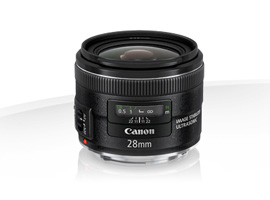Introduction
Features and specifications
Canon’s EF 28mm f2.8 IS USM is a prime lens with 9 elements in 7 groups. It is compact and lightweight, just 51.5mm long and weighing 260g. The image stabilization is rated at 4 stops (by Canon) so the maximum aperture of f2.8 is not likely to be too much of a problem. Autofocus is carried out by one of Canon’s excellent USM motors. 28mm is a good focal length for landscape, architectural, reportage and various other genres of photography. Designed to cover the full frame 35mm format the lens has an equivalent focal length of 45mm when used on an APS-C camera body (Canon body, coefficient 1.6), making this a standard lens.

With a DxOMark score of 26 the Canon 28mm ranks very high. It is the second best of all wide Canon lenses and, if you include independently made lenses, it still ranks 5th out of all canon fit wide lenses. The scores for P-MPix are even better, showing that this is a nice sharp optic, scoring 15P-MPix. If you narrow the field further and look for just 28mm lenses, this one is the top scorer.
The individual test results show a lens that is very consistent, the only place where the scores dip is when used with a small aperture when the resolution does fall off. Chromatic aberration is well controlled, distortion is not excessive transmission is excellent and vignetting, while noticeable when using the lens wide open is exactly what you would expect of a 28mm lens.

Canon EF 28mm f2.8 IS USM vs Canon EF 24mm f2.8 IS USM vs Canon EF 28mm f1.8 USM: Canon progressing nicely!
Here are three lenses that would naturally be on a photographer’s shortlist if they were looking for a wide angle lens for their Canon camera. The 28mm and the 24mm f2.8 lenses were announced together in early 2012 and both sport image stabilization, which is missing on the 28mm f1.8 that has been part of Canon’s range since the middle of 1995. Image stabilization is great to have, especially in a slower lens, giving the photographer the confidence to work hand held. The 28mm f1.8 is, however also the cheapest of the trio so is the extra stop of light a real bargain? Unfortunately not: The 28mm f1.8 is the poorest performer by quite a margin, especially in resolution.

The control of chromatic aberration tells a similar story. While all three lenses are fairly consistent in themselves, the newer two are consistently good where the 28mm f1.8 is consistently just OK.

Canon EF 28mm f2.8 IS USM vs Carl Zeiss Distagon T 28mm f2 ZE vs Sigma 35mm f1.4 DG HSM A: Looking elsewhere for a Wide Lens.

Among Canon’s own lenses the EF 28mm f2.8 IS USM can hold its head high, it performs very well, so is it worth looking further afield too? Carl Zeiss also produces a 28mm lens in Canon fit, their Distagon f2 ZE. Without image stabilization or auto focus this is a lens that needs to perform significantly better to justify costing twice as much: It doesn’t, it actually matches the Canon virtually point for point, it’s only benefit apparently being its wider aperture. However Canon’s image stabilization installed in their 28mm could more than compensate for this loss of a stop leaving the beautifully built Zeiss lens out on a bit of a limb.
If your search is for a wider than standard lens and you are content to accept something a little less wide then another lens you could add to the shortlist is Sigma’s excellent 35mm F1.4 DG HSM A. Only slightly more expensive than the 28mm Canon lens it boast 2 stops of extra light, enough to be able to capture shallow depth of field if you want to and it does perform very well even wide open. It scores higher in DxOMark tests than any other wide lens for Canon. Of course if you need a 28mm then a 35mm isn’t going to be any good, but this is a lens worth keeping in mind.
This Canon EF 28mm f2.8 IS USM is a very good lens, if you are looking for a 28mm lens then really this is the only one that stands out. The relatively slow f2.8 maximum aperture is more than compensated for by the image stabilization in terms of suitability for working in low light. From the point of view of depth of field it will be much harder to get a clear differentiation between sharp focused areas and soft out of focus areas, but a 28mm lens is not the obvious choice for this style of photography anyway. On balance, this is a good and well priced lens that should be given serious consideration.






DXOMARK encourages its readers to share comments on the articles. To read or post comments, Disqus cookies are required. Change your Cookies Preferences and read more about our Comment Policy.